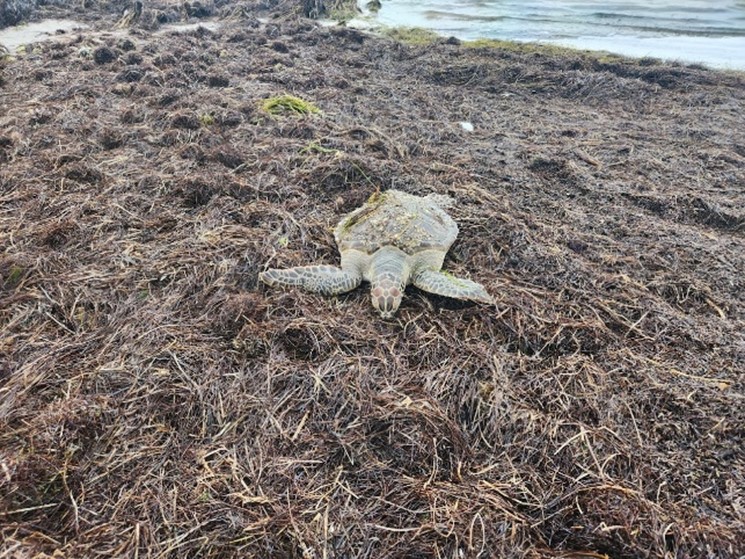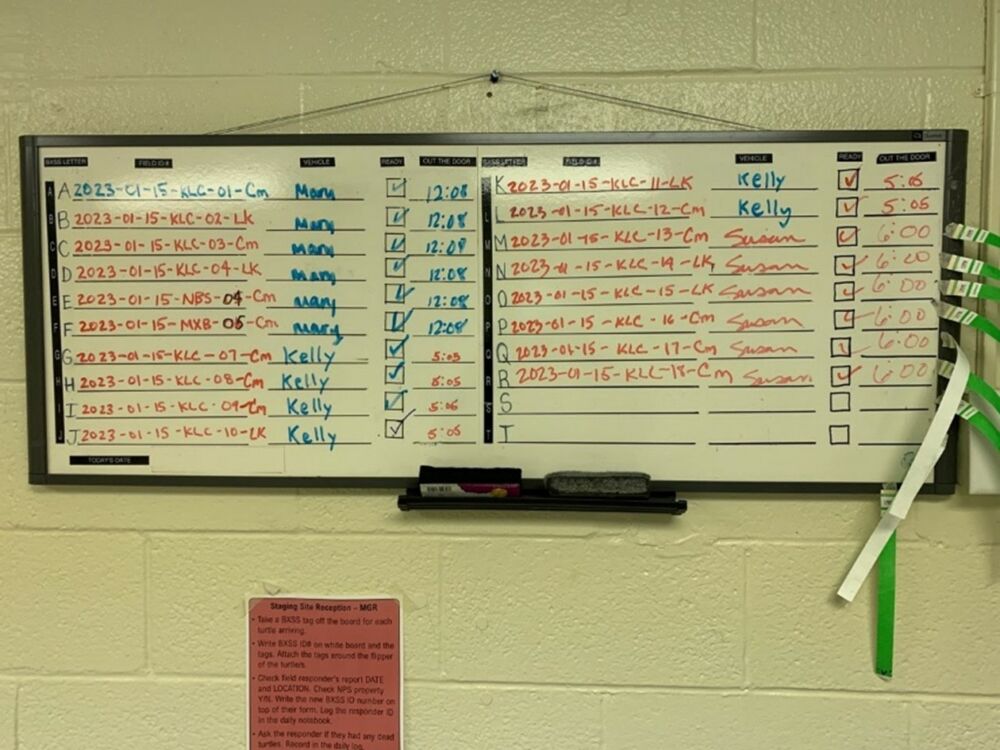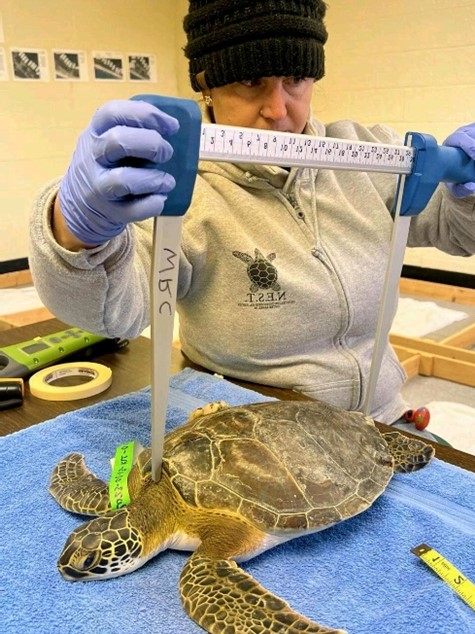By Chris Pruitt It’s been a busy winter for the N.E.S.T. Stranding Response Team and our volunteers at the STAR (Sea Turtle Assistance and Rehabilitation) Center at the North Carolina Aquarium. To quote, Karen Clark (KC), Community Science Specialist with the NC Wildlife Resources Commission and N.E.S.T. Advisor, “these are juvenile animals and we know young people don’t always make the wisest of decisions. Why should they leave when the buffet of the shallow Pamlico sound is right in front of them? What’s one more day?” In general, sea turtles migrate south for the winter. As they are reptiles that cannot regulate their body temps, warm water is critical for their survival. Our waters dip into the 40s a few times in the winter and that can be deadly.
It all started in early December with a live turtle or two found almost daily. Then at Christmas, there was a sudden, steep drop in air and water temperatures. The Buxton staging collection center opened on Dec. 19. On Dec. 24, 47 live turtles were found in one day. On Dec. 25, another 39 live ones, plus now the dead ones showed up. On the 26th another 32. Then a respite from the cold temps just after New Year’s, followed by another cold spell around Jan. 14-18. By the end of January more than 250 turtles had been rescued by N.E.S.T. volunteers.

Cold stunned sea turtle washed up on bank of Pamlico Sound
How do we find them? There is a N.E.S.T. volunteer and weather guru in Buxton by the name of Frank Welles. He explains,
“I watch the long-range weather for air temperatures in the 40s along with strong wind. When that happens, I start checking the water temperature. When the water gets into the 40s and particularly for a couple of days (takes a while for the turtles to get cold), then we start patrolling. It is important to note that this is all happening on the sound side of the island. The reason this all works is that cold weather here is accompanied by onshore wind. The turtles get cold and lethargic and can’t swim. They get blown onto the shore. If the geography was different, we would not be doing this.
There are several established routes that our volunteers and National Park Service patrol. I keep track of who is where and move people around as needed to get coverage. We generally patrol first thing in the morning and if the temperature stays down and the wind up, we do a second patrol in the afternoon. The Christmas cold stun was particularly challenging because naturally many people were away for the holiday. There are several established routes that our volunteers and National Park Service patrol. I keep track of who is where and move people around as needed to get coverage. We generally patrol first thing in the morning and if the temperature stays down and the wind up, we do a second patrol in the afternoon. The Christmas cold stun was particularly challenging because naturally many people were away for the holiday.
While the patrolling is going on we are getting calls about turtles from the public for turtles found in neighborhoods, by duck hunters and fishermen, and by wildlife and fisheries staff. This winter, the staff at the ferry maintenance area in Hatteras have recovered a number of turtles.
We also coordinate with volunteers and the National Park Service on Ocracoke. The turtles found there get put on the ferry and we meet them on this end and get them to STAR.
While we don’t have an exact number probably 80% of the turtles we rescue would not make it if we were not doing this. Some of the turtles wash into areas where people would see them and call one of the hotlines, but the vast majority come from places where people don’t go in the winter.”
All along the North Carolina coast, patrols look for turtles. Statewide, 367 live and 440 dead turtles were found as of February 3rd.
Dare County Schools has allowed N.E.S.T. the use of a small outbuilding in Buxton which was converted into a staging site for stranded cold stuns. KC coordinates the scheduling of volunteers at the site and those providing transport, offering guidance on special handling situations. Volunteers finalize stranding reports, including measurements and other observations, for submission to the national seaturtle.org database. Endangered species animals are carefully tracked.

A board is used at the staging site to keep track of incoming turtles.

Measurements are taken and ID tags are secured on the flippers
Turtles are then transported by yet another group of volunteers to the STAR Center. There, the assessment and treatment begin. The volunteers assist the professional staff in a second intake reporting process which includes weight and vital signs. How do you get a heartbeat? You hold an ultrasound wand to the side of the neck. And a temperature? Same as you would in a newborn child.
There are an amazing number of resources dedicated to the preservation of this species, just in our area. Our cooperative partners include:
North Carolina Wildlife Resources Commission NC Ferry Division
North Carolina Aquarium at Roanoke Island Dare County Schools
North Carolina Aquariums veterinary staff US Coast Guard
Cape Hatter National Seashore Charter Boat Captains of the OBX
Cape Hatteras Secondary School Neighbors and visitors
Sea turtles are one of the oldest living species and we are all committed to their continued survival.
EDUCATIONAL FACT:
The term “cold stunning” refers to the hypothermic reaction that occurs when sea turtles are exposed to prolonged cold-water temperatures (usually below 50°F). Initial symptoms include a decreased heart rate, decreased circulation, and lethargy followed by shock, pneumonia, and possibly death.
Sea Turtles are ‘cold blooded’ so their body temperatures match the water temperatures. When water temperatures drop suddenly, they become ‘stunned’ or too cold to move and swim. If they get lucky, a good breeze pushes them to shore where NEST volunteers and NPS staff find them.
Sea turtles begin to migrate south by late October. It is largely unknown why some sea turtles do not migrate south prior to the drop in water temperatures.
It is thought that animals foraging in shallow bays and inlets become susceptible to cold stunning because the temperatures in these areas can drop quite rapidly and unexpectedly.
